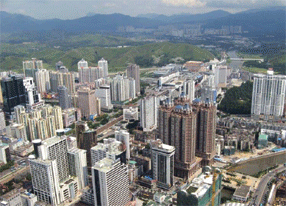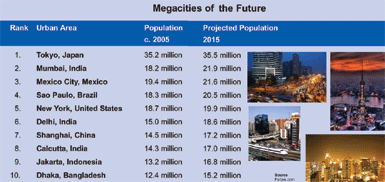The world’s fastest growing cities are found in either Asia or Africa. Out of the 20 fastest growing cities in the world, ten, are in China.
Take emerging megacity, Shenzhen: A small town until 1980, Shenzhen experienced an unparalleled population and economic boom after being designated a free trade zone. Today, Shenzhen has more than 7 million inhabitants, due largely to its prime location on the Pearl River delta – the age-old trend of civilizations to gravitate towards water sources. This is 23 times its population only thirty years ago, according to the UN.
Massive urbanization has arrived in China. If current trends prove correct, the country’s urban population will reach 1 billion by 2030 (there are currently about 1.3 billion Muslims in the entire world).
New research released by the McKinsey Global Institute (MGI) estimates 320 million more people will be added to China’s cities by 2025. This is more than the entire population of the United States today, just over 305 million.
Currently, China has a hundred cities with a population of over one million. In 20 years, it will add more than a hundred more cities of this size, and at least six more megacities containing populations over 10 million people.
While this exponential growth will have a positive impact on the country’s GDP (MGI estimates increases up to 20 percent), it also carries serious challenges and consequences.
To meet what is considered an “unprecedented transformation” in history, governments at both national and local levels must proactively implement policies now.
Decisions that China makes today will determine whether its cities struggle to cope with growth (e.g. like Mexico City, Mumbai or Sao Paulo) or emerge as “world-class” megacities, with new markets and opportunities for business.
“To understand the dynamics of the megacities is also to understand their dilemmas,” writes Dr. George Bugliarello, University Professor and Chancellor , Polytechnic University, Brooklyn, New York.
Megacities are where both problems and opportunities are visible on a larger scale. What happens in megacities have a greater impact on the rest of the world. The UN’s ‘State of the World Population 2007’ notes that “No country in the industrial age has ever achieved significant economic growth without urbanization.”
“Urbanization is unavoidable,” states Chief of the UN Populations Fund’s Resource Mobilization Branch, Jean-Noel Wetterwald. “The concentration of people concentrate the problems, but also concentrate the solutions.”
Urban Migrants
A report released by Deutsche Bank Research in March of this year, ‘Megacities: Boundless Growth?’ cites the growth of cities as fastest in those countries with a “big gap between rural and urban incomes.” The larger the difference between urban incomes and rural incomes, the faster cities expand.
With 230 million migrants expected to move from the countryside into China’s “new” cities, MGI forecasts that migration will account for about 70 percent of urban population growth over the next two decades. Most people migrate to cities expecting higher wages and an improvement in their standard of living.
In many instances, they also don’t have much of a choice. One of the reasons why more megacities are forming at this particular time is history is because of the loss of arable land. In China alone some 3,000 to 6,0000 square kilometers of farmland are estimated to be lost each year, cites Deutsche Bank Research.
The reasons? Industrialization, unsustainable farming methods, and climate change.
The Deutsche Bank research cites other reasons why, soon, most of the world will live in cities. Among these include:
Population Growth:
Megacities are largely the result of longer life spans due to advances in hygiene and medicine.
Technological Revolution: “Globalization and digitization” drive the economic development of megacities because of the way they cluster markets and skilled workers together.
Opportunities for Investment:
More investment opportunities are to be found in cities than in rural areas.
Mega-problems
Dr. Bugliarello is also Editor-in-Chief of The Bridge, the quarterly publication of the National Academy of Engineering. “Megacities are currently experiencing rapid growth with which they cannot cope,”
This creates a host of problems, including: Population growth; poverty increase; infrastructure problems in transportation and communications; land and housing pressures (i.e. On average, China “concentrates” 5.7 persons to a room, as compared to 0.5 in the US); environmental concerns; economic dependence; and capital scarcity.
Staggering Urbanization
Chongqing is a good illustration: Built along the Yangtze River, this former port town has grown to become one of China’s major economic hubs, and out of all the megacities in China, is purported to be the “fastest-growing urban center on the planet.”
If the day he spent in Chongqing is “typical,” says The Guardian writer Jonathan Watts, then “builders will lay 137,000 square meters of new floor space for residential blocks, shopping centres and factories. The economy will grow by 99 million yuan. There will be 568 deaths, 813 births and the arrival of 1,370 people from the countryside.”
Watts points out the incongruities in this emerging metropolis. From the “bangbang army” -a 100,000- strong crew of porters who carry heavy bundles of goods between Chongqing’s markets and earn approximately 20 Yuan a day (USD $2.9) – to the new, richer urbanites who have moved “off the land and into the sky.”
Implications
Urbanites tend to produce less and consume more, making demand for energy and water one of the biggest dilemmas of our times.
MGI forecasts the demand for energy in China’s urban areas is likely to more than double; and demand for water will increase by 70 to 100 percent.
This article is under Copyright 2003-08. Galt Western Personnel and has been tailored for TBL with permission from the Galt Global Review, www.galtglobalreview.com.








Absolutely great article, very informative. Congratulations